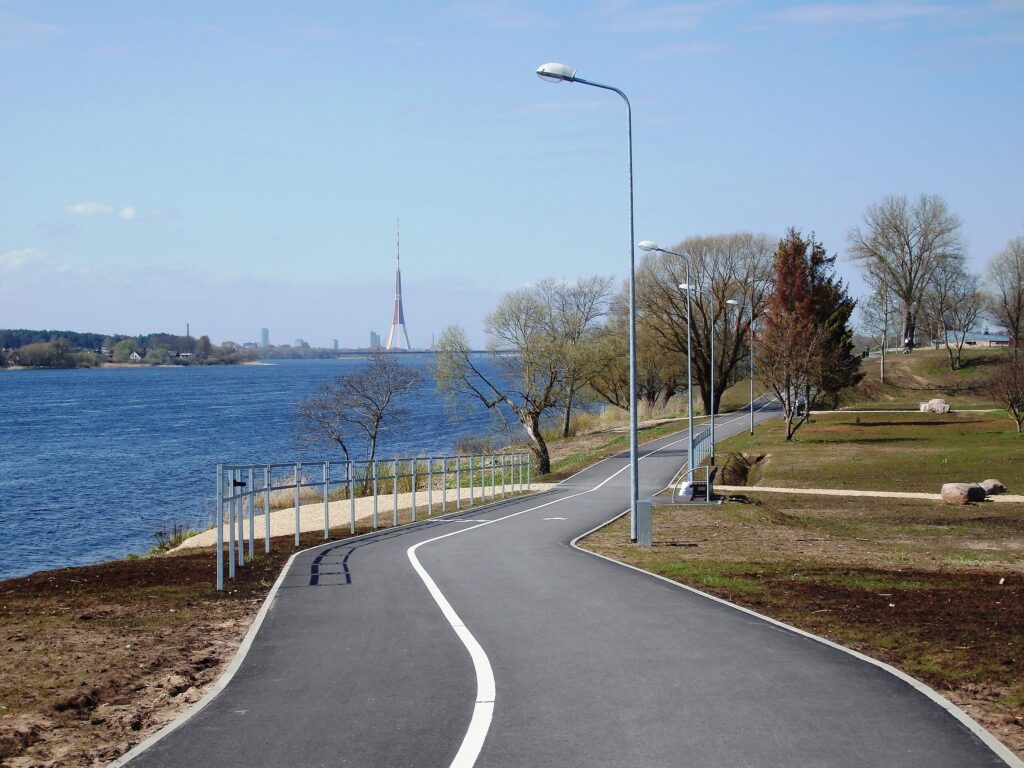The mayors of Riga, Tallinn, and Vilnius made a joint appeal to Google on September 16, demanding complete and up-to-date representation of cycling infrastructure across the three Baltic capitals in Google Maps.
Riga Mayor Viesturs Kleinbergs joined his counterparts Jevgeni Ossinovski from Tallinn and Valdas Benkunskas from Vilnius in the unprecedented regional collaboration targeting the tech giant’s mapping service.
The initiative addresses a growing frustration among Baltic cities that have invested heavily in cycling infrastructure over the past decade, only to see their efforts remain invisible in the world’s most popular navigation app.
Riga’s Cycling Revolution
Riga has built 165 kilometers of bike lanes in the last ten years — the most extensive network among the three Baltic capitals. The Latvian capital’s commitment to sustainable urban mobility has transformed entire districts, creating dedicated cycling corridors that connect residential areas to business centers.
Despite this massive infrastructure development, cyclists in Riga cannot rely on Google Maps for route planning. The app fails to recognize bike lanes, forcing users to navigate using incomplete information or alternative mapping services.

“We have invested significantly in cycling infrastructure to enable residents to move safely, conveniently, and environmentally sustainably,” the mayors wrote in their joint letter. “However, this infrastructure is not reflected in the digital space, making it invisible to many users and preventing adequate trip planning.”
Digital Invisibility Problem
The absence of bike lane data in Google Maps creates multiple problems for Riga’s cycling community. Tourists visiting the city struggle to navigate the extensive network, while locals cannot optimize their daily commutes using the world’s most popular mapping platform.
Urban mobility experts emphasize that digital representation is crucial for infrastructure utilization. When bike lanes don’t appear on widely-used navigation apps, people are less likely to discover and use them.
The mayors have already provided Google with all necessary data about their cycling networks. They’re now demanding immediate integration and real-time updates when new infrastructure comes online.
Regional Cooperation Strategy
The joint appeal represents a new approach to dealing with international tech companies. Rather than individual city requests that often go unanswered, the Baltic mayors are leveraging collective pressure.
Tallinn has repeatedly attempted to contact Google about bike lane representation without success. Mayor Ossinovski noted that Google’s corporate structure makes it difficult to reach decision-makers who can authorize map updates.
“Google is such a peculiar organization that you don’t get an answer from there,” Ossinovski told Estonian media. “Our belief is that with an appeal at the political level, the response could be different this time.”
Infrastructure Quality Concerns
While the mayors push for digital recognition, cycling advocates acknowledge that infrastructure quality varies across the Baltic capitals. In Tallinn, well-segregated bike paths sometimes abruptly end at sidewalks or merge with vehicle traffic.
Urban mobility expert Tõnis Savi suggests that some Baltic cycling infrastructure may not meet Google’s standards for inclusion in their mapping service.
“If we look at where and what these cycle routes are, then there’s nothing to be done. Quite a large part of them actually do not meet standards or the city’s own goals as set,” Savi said.
However, Riga’s cycling network generally maintains higher continuity standards than its Baltic neighbors, with most routes offering protected separation from vehicle traffic.
Comparison with Other Cities
The Baltic capitals lag behind other European cities in digital cycling infrastructure representation. Helsinki, Copenhagen, and Amsterdam have had their bike networks fully integrated into Google Maps for years.
This digital divide affects tourism and urban planning. Cities with visible cycling infrastructure in navigation apps see higher bike usage rates and better integration with public transportation systems.
The mayors argue that their cities deserve equal treatment, especially given their substantial infrastructure investments and growing cycling communities.
Future Expansion Plans
All three Baltic capitals plan to expand their cycling networks significantly in coming years. Riga has announced plans for additional protected bike lanes connecting outer districts to the city center.
The mayors emphasize that future infrastructure development should immediately appear in Google Maps, rather than requiring separate appeals for each project.
“We requested that in the future, changes would be reflected in the application in a timely manner,” they wrote in their joint statement.
Economic and Safety Impact
Proper digital representation of cycling infrastructure has economic implications. Cities with comprehensive bike lane mapping see increased tourism from cycling enthusiasts and higher property values along cycling corridors.
Safety also improves when navigation apps can direct cyclists to protected infrastructure rather than busy streets. Google Maps typically routes cyclists to quieter side streets when dedicated infrastructure isn’t mapped.
The Baltic capitals argue that accurate digital mapping is essential for achieving their sustainable transportation goals and maximizing return on infrastructure investments.
Tech Company Accountability
The joint appeal highlights broader questions about tech company responsibility for accurate civic infrastructure representation. As Google Maps becomes increasingly central to urban navigation, cities argue they deserve responsive service for infrastructure updates.
The Baltic mayors’ coordinated approach could serve as a model for other regions frustrated with tech companies’ slow response to municipal requests.
Their letter emphasizes that proper bike lane representation supports public health, environmental goals, and economic development — priorities that align with Google’s stated corporate values.
Regional Cycling Growth
Cycling culture has exploded across the Baltics in recent years. Tallinn organizes regular Tour D’Öö evening cycling events that attract hundreds of participants. Riga hosts similar community rides that showcase the city’s expanding network.
Vilnius has seen dramatic increases in cycling participation, particularly among young professionals commuting to tech sector jobs. The Lithuanian capital’s 170 kilometers of bike lanes reflect this growing demand.
This regional cycling boom makes the Google Maps gap more frustrating for local officials who see digital representation as crucial for continued growth.
The mayors expect Google to respond to their joint appeal within weeks rather than months, given the coordinated political pressure and complete data provision.
Their success could encourage similar regional cooperation on tech company engagement, potentially reshaping how cities interact with digital platform providers.



